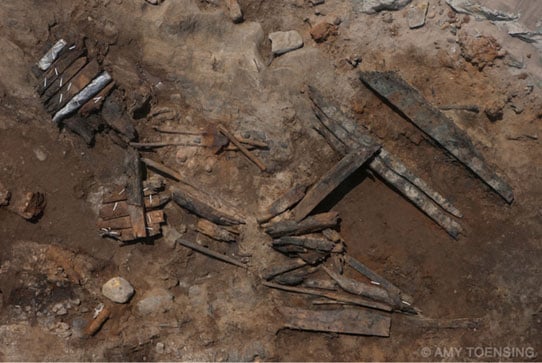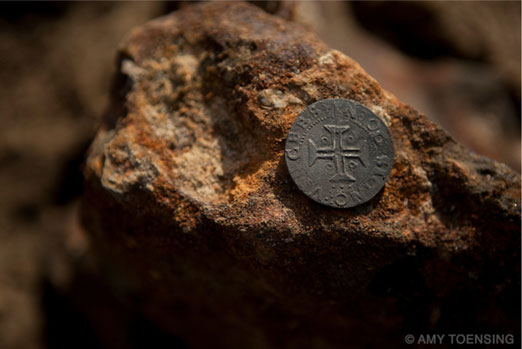
 |
|
|||||||
 |
|
|
Thread Tools | Search this Thread | Display Modes |
|
|
|
|
#1 |
|
(deceased)
Join Date: Sep 2008
Location: Bavaria, Germany - the center of 15th and 16th century gunmaking
Posts: 4,310
|
http://www.ancient-origins.net/ancient-places-africa/misfortune-bom-jesus-diamond-shipwreck-001731#!bCExlR
8 June, 2014 - 00:53 The Misfortune of the Bom Jesus, the Diamond Shipwreck The so-called Age of Discovery in Europe began in the early 15th century, and produced numerous well-known explorers such as Vasco da Gama, Ferdinand Magellan, and Christopher Columbus. But there were countless others who lost their lives undertaking their perilous journeys, and as a result, became lost to the pages of history. Nevertheless, the discovery of shipwrecks, lying like skeletons on the ocean floor, resurrects the stories of these long-forgotten explorers, as researchers attempt to piece together the events of their voyage and the circumstances in which they met their final fate. One such example is the ‘Diamond Shipwreck’. This was a shipwreck discovered in the sands of the Sperrgebiet (meaning ‘Prohibited Area’ in German), which is the rich and off-limits De Beers diamond-mining lease near the mouth of the Orange River on Namibia’s southern coast. In 2008, a company geologist working in the mining area U-60 came across what seemed to be a perfectly half sphere of rock. After picking up this rock and having a closer look at it, he realized that it was actually a copper ingot. On its weathered surface was a peculiar trident-shaped mark, which turned out to be the hallmark of Anton Fugger, one of Renaissance Europe’s wealthiest financiers.  weapons (arquebuses and swords), armor, bronze cannons, cannon balls, pewter bowls, ivory tusks, and of course gold. The gold was in the form of coins, more than 2,000 in total, mainly Spanish excelentes bearing the likenesses of the monarchs Ferdinand and Isabella, but also some Venetian, Moorish, French and other coinage. As the shipwreck was in the middle of one of the world’s most jealously guarded diamond mines, it is little wonder that its contents had been safe from treasure hunters all this time.  No story is complete, however, without actors. Based on the available clues, it has been suggested that the ‘Diamond Shipwreck’ was once a ship called the Bom Jesus (Good Jesus). This ship was captained by a Dom Francisco de Noronha, and carried around 300 sailors, soldiers, merchants, priests, nobles, and slaves. There has also been some speculation about the fate of these men. For a start, the only human remains recovered from the wreck are several toe bones in a shoe found pinned beneath a mass of timbers. Furthermore, few personal belongings were among the artefacts. Thus, archaeologists believe that many on board the ship managed to make it to dry land. Nevertheless, the harsh conditions of the land may have killed them off, as it was a barren wasteland that stretched for hundreds of kilometres, and it was winter. On the brighter side, the Orange River lay about 25 kilometers to the south of the shipwreck, and the castaways may have made it there. Moreover, the Portuguese might have met natives, as winter was the season when indigenous tribes ventured along the shore in search of the carcasses of southern right whales that were occasionally washed ashore. In short, it appears that we will never know the final fate of these adventurers. ************************************************** ************************************************** ************************************************** **************************** While most people still seem to be interested in diamonds and gold most of all, dreaming their 'pirates' vision inspired dreams, my first thought was right away: THE c. 1525 type NUREMBERG SNAP-TINDERLOCK ARQUEBUSES that, among other goods, the Bom Jesus was taking to India! Way before even taking a first glance at what actually turned out to be two stamp-size (!) printed photos, showing some details of an arquebus stock salvaged, I was well aware of the doubtless fact that the Nuremberg gunmakers guild was trying to sell off first, and especially overseas!, the remaining number of a technically outdated model of Landsknecht guns - rather than the latest stage of Nuremberg technologic evolution of mechanism (in terms of all mechanical parts being united on an iron! lock plate). So I feel sufficiently sure to exactly predict what the mechanisms of the Bom Jesus arquebuses must have looked like - before even getting a glimpse of an actually salvaged specimen. And mind you: At least a chest full of completely preserved arqebuses was found: See attachments no. 2 and 3! Best, Michl/Michael Michael Trömner Rebenstr. 9 D-93326 Abensberg Germany Self-established Academic Medievalist Graduated from Regensburg University in 1982 Stipendiary recipient and Member of the Studienstiftung des deutschen Volkes, Bonn Author of BEHÄLTNISSE FÜR KOSTBARES 1500-1700, 2005 Member of vikingsword.com, with more than 4.100 threads and posts since 2008 M. of the Arms & Armour Society, London since 1991 M. of the Gesellschaft für Historische Waffen- und Kostümkunde e.V., Berlin since 1987 Expertises in European weapons, ironworks and furniture of the 14th through 17th centuries Preservation and scientific documentation of museum collections Last edited by Matchlock; 14th August 2014 at 02:06 PM. |
|
|

|
|
|
#2 |
|
(deceased)
Join Date: Sep 2008
Location: Bavaria, Germany - the center of 15th and 16th century gunmaking
Posts: 4,310
|
I definitely doubt the alledged fact that attachment no. 1 shows a touch hole prick (German: Räumnadel); in my opinion, this long needle with the double scroll to its upper end was a bodkin used for long hair.
Such a long and delicate object would have bent and broken right away, at the very first tryto prick the fouled-up touch hole of any gun ... Further down in this thread, I will attach photos of two actual wrought iron pricks preserved in The Michael Trömner Collection. Best, Michael Trömner Last edited by Matchlock; 14th August 2014 at 02:34 PM. |
|
|

|
|
|
#3 |
|
(deceased)
Join Date: Sep 2008
Location: Bavaria, Germany - the center of 15th and 16th century gunmaking
Posts: 4,310
|
Attached to this and the following post, find some photos
of Nuremberg made snap-tinderlock arquebuses with lateral push-button triggers, and with only the serpentine riveted on a small brass plate while all the other mechanical parts like the long forward-mounted one-armed main spring (mostly made of hammered brass) were inlaid in recesses cut out of the stock, and covered up with a thin plate of wood. A long brass-hammered spring of exactly this type is illustrated on one of the scans I made of photos of arquebuses discovered in the wreck of the Bom Jesus. The arquebuses on my photos are preserved in the historical armories of the Západočeské muzeum v Plzni, Czechia, and the Brukenthal-Museum Sibiu, Romania. Please note the Nuremberg control mark struck as a sign of quality on the barrel of one of the Sibiu arquebuses. The latest stage of technological development, now uniting all parts of snap-tinder/snap-matchlock mechanism on one iron lock plate, Nuremberg, ca. 1530, is represented by a short arquebus preserved in the reserve collection/storage rooms of the Hessisches Landesmuseum Darmstadt (bottom attachments). Although the lock mechanism is missing from the latter gun, the lock recess cut out of the limewood full stock clearly denotes its pointed triangular shape. Please also note that this arquebus, for the first time, features the 'modern' form of a trigger (German: Züngleinabzug or Abzugszüngel), which is protected by a rectangular trigger guard! Please also cf. Alexender's threads: http://www.vikingsword.com/vb/showth...ht=zapadoceske http://www.vikingsword.com/vb/showth...ht=zapadoceske and my threads: http://www.vikingsword.com/vb/showth...ht=zapadoceske http://www.vikingsword.com/vb/showth...ht=zapadoceske Best, Michael Photos of the Pilsen and Darmstadt arquebuses copyrighted by the author, Michael Trömner. Photos of the Sibiu arquebusees copyrighted by the Brukenthal-Museum Sibiu/Hermannstadt. Last edited by Matchlock; 14th August 2014 at 03:23 PM. |
|
|

|
|
|
#4 |
|
(deceased)
Join Date: Sep 2008
Location: Bavaria, Germany - the center of 15th and 16th century gunmaking
Posts: 4,310
|
Top 5 attachments:
A Nuremberg made snap-tinder/snap-matchlock arquebus of ca. 1530, the lock recess showing the contours of a triangular shaped lock plate which united all the mechanical parts of the action. Together with a contemporary Italian snap-tinderlock arquebus preserved in The Michael Trömner Collection, this gun at the storage rooms of the Hessisches Landesmusum Darmstadt, inv.-no. W 61:100, is the oldest known gun to feature, for the first time, showing the presence of the 'modern' type of trigger replacing the lateral push-button that had been used to trigger the snapping serpentines from ca. 1490-1530. Furthermore, these two contemporary arquebuses of ca. 1530 are equipped with a vertical type of trgigger guard, for protection of the first triggers mounted on the underside of the stock, beneath the lock mechanism. The Nuremberg made arquebus in Darmstadt features an especially delicate type of trigger. Attachment no. 6 depicts an action of the very same type, on another Nuremberg imported arquebus in the Brukenthal-Museum Sibiu, ca. 1530-35. The author's thesis is that the arquebuses on the Bom Jesus were not yet equipped with that kind of 'modern' triggers and trigger guards. Best, Michael All photos copyrighted by the author, Michael Trömner. Last edited by Matchlock; 14th August 2014 at 03:58 PM. |
|
|

|
|
|
#5 |
|
Member
Join Date: Nov 2012
Location: Southeast Florida, USA
Posts: 429
|
You have outdone yourself again Michael!
I only wish I could read German. None of the articles (and photos!) I have found on the Bom Jesus in English can match the one you've posted here. |
|
|

|
|
|
#6 | |
|
(deceased)
Join Date: Dec 2004
Location: Portugal
Posts: 9,694
|
Quote:
Also the Spanish gold "excelentes", which represent 70% of the gold coins present in the wreck, are a vital detail for history, as it didn't occur to archeologists that the Spanish investors, as it appears, had a great contribution to this Portuguese expedition, such an unusual fact. |
|
|
|

|
|
|
#7 |
|
(deceased)
Join Date: Sep 2008
Location: Bavaria, Germany - the center of 15th and 16th century gunmaking
Posts: 4,310
|
Thank you so much, Dana W and Nando!
I'm trying to make contacts with one of the authors, Dr. Wolfgang Knabe, in order to get more and better images! After all, I can tell them a whole lot on these guns that they don't know, so it will be worth swapping facts, thoughts and theories - and I'm looking forward to an enthralling exchange of important pieces of our minds. Best, m |
|
|

|
 |
|
|